fastjson处理Map的 key 为 int 的bug
JSON 中的 MAP 是不支持 int 为 key 的;
Map<Integer, String> map = new HashMap<>();
map.put(1, "one");
map.put(2, "two");
System.out.println(JSON.toJSONString(map));
// {1:"one",2:"two"}标准的json规范中,要求对象的key必须为string
JSON 中的 MAP 是不支持 int 为 key 的;
Map<Integer, String> map = new HashMap<>();
map.put(1, "one");
map.put(2, "two");
System.out.println(JSON.toJSONString(map));
// {1:"one",2:"two"}标准的json规范中,要求对象的key必须为string
import com.yahoo.platform.yui.compressor.CssCompressor;
import org.apache.commons.io.IOUtils;
import java.io.*;
public class YUIProcessor {
public String compressCss(String code) {
Reader in = new InputStreamReader(IOUtils.toInputStream(code));
try (Writer out = new StringWriter()) {
CssCompressor compressor = new CssCompressor(in);
compressor.compress(out, -1);
out.flush();
return out.toString();
} catch (IOException e) {
e.printStackTrace();
}
return "";
}
}追加:
yui compresser 很久没有更新,有很多的不足,已经废弃使用。
图中的黑色位都可以不关注,然后基本原理就是这样的 (以8位作为例子)
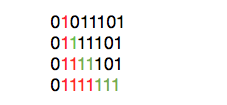
0x55555555
01010101010101010101010101010101
0x33333333
00110011001100110011001100110011
0xf0f0f0f
00001111000011110000111100001111
0x3f
00000000000000000000000000111111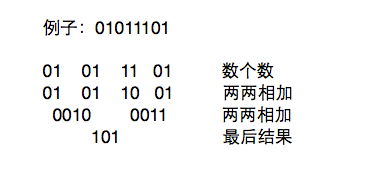
先来个 Apache Commons 里面没有的
/*
[
{id: 1, name: "name1", gender: 1},
{id: 2, name: "name2", gender: 1},
{id: 3, name: "name1", gender: 2},
]
*/
/*
[1, 2]
*/
CollectionUtils.pluck(persons, "id", new ArrayList<Integer>())
/*
{
1: [
{id: 1, name: "name1", gender: 1},
{id: 2, name: "name2", gender: 1},
],
2: [
{id: 3, name: "name1", gender: 2},
]
}
*/
CollectionUtils.groupBy(persons, "gender", Integer.class)
/*
去重
*/
CollectionUtils.unique(integers, new ArrayList<Integer>())Apache Commons 里面的
StringUtils.isEmpty(); // null 和 空字符串
StringUtils.isBlank(); // null 和 空字符串 和 全空白字符串
StringUtils.trim(); // 截取掉字符串两侧的空格
StringUtils.strip(); // 截取掉字符串两侧的空白字符串
StringUtils.equalsIgnoreCase(); // 忽略大小写的比较
StringUtils.indexOf(); // 字符/字符串在指定字符串中第一次出现的位置
StringUtils.indexOfIgnoreCase();
StringUtils.lastIndexOf();
StringUtils.contains(); // 是否包含子符串
StringUtils.left();
StringUtils.right();
StringUtils.mid(); // 截取字符串
StringUtils.split(); // 分割字符串
StringUtils.join(); // join数组为字符串
StringUtils.repeat(); // 重复输出字符串
StringUtils.leftPad();
StringUtils.rightPad(); // 填充字符串
StringUtils.lowerCase();
StringUtils.upperCase();
StringUtils.capitalize(); // 大写首字母
StringUtils.reverse(); // 倒转字符串额,大多数提供的都跟PHP里面一样
CollectionUtils.union(); // 并集
CollectionUtils.intersection(); // 交集
CollectionUtils.containsAny(); // 是否存在交集
CollectionUtils.disjunction(); // 交集的补集
CollectionUtils.subtract(); // 差集
CollectionUtils.filter(); // 过滤空List的返回
// new ArrayList<>();
Collections.emptyList();检测端口可用,(绑定,并关掉),来自 Canal
public static boolean isAvailablePort(int port) {
ServerSocket ss = null;
try {
ss = new ServerSocket(port);
ss.bind(null);
return true;
} catch (IOException e) {
return false;
} finally {
if (ss != null) {
try {
ss.close();
} catch (IOException e) {
}
}
}
}利用字符串标记,优雅解决内外配置文件的加载
// ...
private static final String CLASSPATH_URL_PREFIX = "classpath:";
// ...
String conf = System.getProperty("canal.conf", "classpath:canal.properties");
Properties properties = new Properties();
if (conf.startsWith(CLASSPATH_URL_PREFIX)) {
conf = StringUtils.substringAfter(conf, CLASSPATH_URL_PREFIX);
properties.load(CanalLauncher.class.getClassLoader().getResourceAsStream(conf));
} else {
properties.load(new FileInputStream(conf));
}目录结构如下
.
├── main
│ ├── java
│ │ └── lu
│ │ └── tool
│ │ └── jar
│ │ ├── InterfaceRunner.java
│ │ └── Loader.java
│ └── resources
└── test
├── java
└── resourcesInterfaceRunner.java 为挂载 jar 中类的实现接口
Loader.java 为jar的加载器和执行器
所有第三方包的jar路径,通过 web 界面管理,然后存储在一个文件中,这里不实现 web 的管理。
InterfaceRunner.java:
package lu.tool.jar;
/**
* Created by xiaozi on 11/29/14.
*/
public interface InterfaceRunner {
public void fire();
}Loader.java
package lu.tool.jar;
import java.io.*;
import java.net.URL;
import java.net.URLClassLoader;
/**
* Created by xiaozi on 11/29/14.
*/
public class Loader {
public static void main(String[] args) {
String configFile = System.getProperty("jar.conf");
if (configFile == null || configFile.isEmpty()) {
System.exit(1);
}
System.out.println(configFile);
File file = new File(configFile);
try {
BufferedReader in = new BufferedReader(new FileReader(file));
String s;
while ((s = in.readLine()) != null) {
if (s.isEmpty()) continue;
System.out.println(s);
URL url = new URL(s);
URLClassLoader myClassLoader = new URLClassLoader(new URL[] {url}, Thread.currentThread().getContextClassLoader());
Class<?> myClass = myClassLoader.loadClass("lu.tool.jar.Runner");
InterfaceRunner action = (InterfaceRunner) myClass.newInstance();
// 达到指定条件的时候触发,这里仅是个演示
// 在没有优先级的执行条件下应该使用子进程的方式,防止其中的一个crash掉
action.fire();
myClassLoader.close();
System.out.println("done");
}
} catch (FileNotFoundException e) {
e.printStackTrace();
} catch (IOException e) {
e.printStackTrace();
} catch (ClassNotFoundException e) {
e.printStackTrace();
} catch (InstantiationException e) {
e.printStackTrace();
} catch (IllegalAccessException e) {
e.printStackTrace();
}
}
}jar.conf 存放 jar 的本地的绝对路径
file:///Users/xiaozi/Documents/testrunner/out/artifacts/testrunner_jar/testrunner.jar被挂载jar包中的类实现
package lu.tool.jar;
/**
* Created by xiaozi on 11/29/14.
*/
public class Runner implements InterfaceRunner {
@Override
public void fire() {
System.out.println("Hello, I'm in another jar!");
}
}由于 tool.lu 的流量还不是很大,所以我把每次的访问记录都存到了MySQL(如果流量大,这么做是作死的节奏)
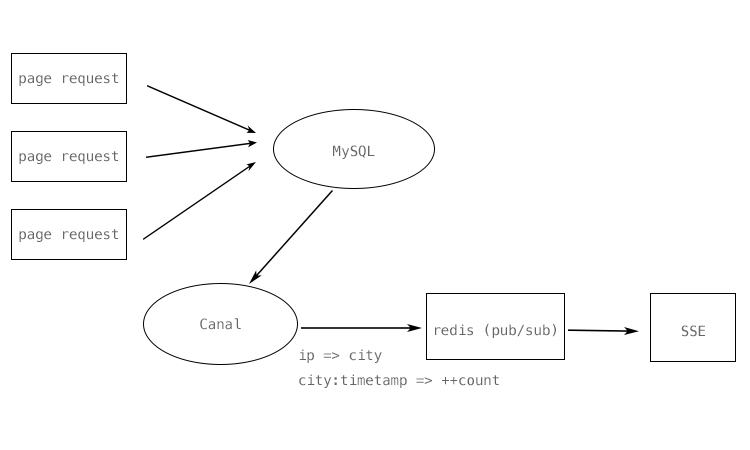
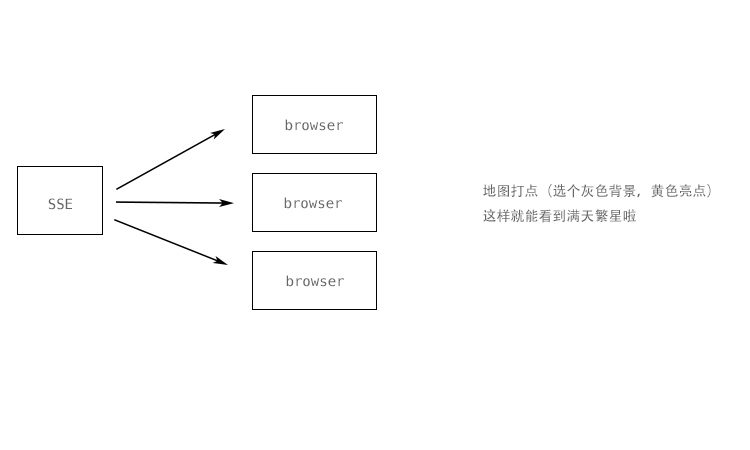
使用canal做异步处理,主要是因为
其中cannal分发的数据处理是用的java,本打算sse也用java的netty来实现了,惭愧,尝试未果后就放弃了,最后用golang实现的。
这样做不会太耗性能,而且每秒钟往客户端传输一次数据,但是由于 vps 的内存有限,java 又比较吃内存,所以上线之后就直接下线了。
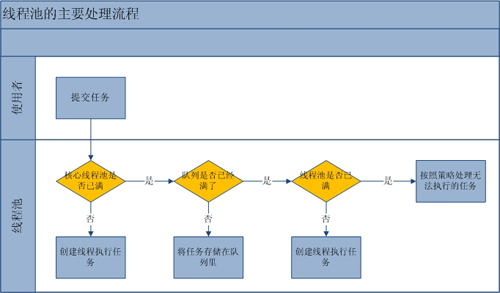
newCachedThreadPool();
newFixedThreadPool();
newScheduledThreadPool();
newSingleThreadExecutor();ScheduledThreadPool使用优先级队列进行排序(距离下次调度间隔短的任务排在前面)
DelayedWorkQueue
package lu.tool.demo;
import java.util.concurrent.*;
/**
* Created by xiaozi on 14-8-28.
*/
public class CachedThreadPoolDemo {
public static void main(String[] args) {
ExecutorService es = Executors.newCachedThreadPool();
ThreadPoolExecutor tpe = (ThreadPoolExecutor) es;
// tpe.setMaximumPoolSize(100);
Future<?> future = null;
// for (int i = 1; i < 8000; i++) {
for (int i = 1; i < 100; i++) {
future = tpe.submit(new TaskDemo());
}
System.out.println("largest pool size: " + tpe.getLargestPoolSize());
System.out.println("task count: " + tpe.getTaskCount());
if (future != null) {
try {
future.get();
} catch (InterruptedException e) {
e.printStackTrace();
} catch (ExecutionException e) {
e.printStackTrace();
}
}
// tpe.shutdown();
}
}package lu.tool.demo;
import java.util.concurrent.ExecutorService;
import java.util.concurrent.Executors;
import java.util.concurrent.ThreadPoolExecutor;
/**
* Created by xiaozi on 14-8-28.
*/
public class FixedThreadPoolDemo {
public static void main(String[] args) {
ExecutorService es = Executors.newFixedThreadPool(100);
ThreadPoolExecutor tpe = (ThreadPoolExecutor) es;
for (int i = 1; i < 8000; i++) {
tpe.submit(new TaskDemo());
}
tpe.shutdown();
}
}package lu.tool.demo;
import java.util.concurrent.*;
/**
* Created by xiaozi on 14-8-28.
*/
public class ScheduledThreadPoolDemo {
public static void main(String[] args) {
ScheduledExecutorService es = Executors.newScheduledThreadPool(100);
for (int i = 1; i < 8000; i++) {
es.schedule(new TaskDemo(), 3, TimeUnit.SECONDS);
}
// scheduleAtFixedRate
// scheduleWithFixedDelay
es.shutdown();
}
}package lu.tool.demo;
import java.util.concurrent.ExecutorService;
import java.util.concurrent.Executors;
/**
* Created by xiaozi on 14-8-28.
*/
public class SingleThreadExecutorDemo {
public static void main(String[] args) {
ExecutorService es = Executors.newSingleThreadExecutor();
for (int i = 1; i < 8000; i++) {
es.submit(new TaskDemo());
}
es.shutdown();
}
}ThreadPoolExecutor(int corePoolSize,
int maximumPoolSize,
long keepAliveTime,
TimeUnit unit,
BlockingQueue<Runnable> workQueue,
RejectedExecutionHandler handler);| 参数 | 解释 |
|---|---|
| corePoolSize | 线程池维护线程的最少数量 |
| maximumPoolSize | 线程池维护线程的最大数量 |
| keepAliveTime | 线程池维护线程所允许的空闲时间 |
| unit | 线程池维护线程所允许的空闲时间的单位 |
| workQueue | 线程池所使用的缓冲队列 |
| handler | 线程池对拒绝任务的处理策略 |
package lu.tool.demo;
import java.util.concurrent.ArrayBlockingQueue;
import java.util.concurrent.ThreadPoolExecutor;
import java.util.concurrent.TimeUnit;
/**
* Created by xiaozi on 14-8-29.
*/
public class ThreadPoolExecutorDemo {
public static void main(String[] args) {
ThreadPoolExecutor tpe = new ThreadPoolExecutor(3, 5, 60,
TimeUnit.SECONDS, new ArrayBlockingQueue<Runnable>(10),
new ThreadPoolExecutor.CallerRunsPolicy());
for (int i = 1; i < 8000; i++) {
tpe.submit(new TaskDemo());
}
tpe.shutdown();
}
}ArrayBlockingQueu // 有界
LinkedBlockingQueue // 无界
SynchronousQueue
PriorityBlockingQueuebeforeExecute(Thread t, Runnable r)
afterExecute(Runnable r, Throwable t)
executor.getTaskCount();
executor.getCompletedTaskCount();
executor.getLargestPoolSize();
executor.isShutdown();
executor.isTerminated();锁
| 线程池 | 队列 | 锁 | |
|---|---|---|---|
| ScheduledThreadPool | DelayedWorkQueue | ReentrantLock.newCondition | available |
| FixedThreadPool | LinkedBlockingQueue | ReentrantLock.newCondition | put, take |
| CachedThreadPool | SynchronousQueue | ReentrantLock | |
| SingleThread | LinkedBlockingQueue | ReentrantLock.newCondition | put, take |
java --cp $(JARS=("$LIB"/*.jar); IFS=:; echo "${JARS[*]}") -jar you-project-jar.jarpom.xml
<project xmlns="http://maven.apache.org/POM/4.0.0" xmlns:xsi="http://www.w3.org/2001/XMLSchema-instance"
xsi:schemaLocation="http://maven.apache.org/POM/4.0.0 http://maven.apache.org/xsd/maven-4.0.0.xsd">
<modelVersion>4.0.0</modelVersion>
<groupId>com.tool.js</groupId>
<artifactId>js-tool</artifactId>
<version>1.0</version>
<packaging>jar</packaging>
<name>js-tool</name>
<url>http://tool.lu</url>
<properties>
<project.build.sourceEncoding>UTF-8</project.build.sourceEncoding>
</properties>
<dependencies>
<dependency>
<groupId>org.apache.thrift</groupId>
<artifactId>libthrift</artifactId>
<version>0.9.1</version>
</dependency>
<dependency>
<groupId>com.google.javascript</groupId>
<artifactId>closure-compiler</artifactId>
<version>v20140407</version>
</dependency>
<dependency>
<groupId>org.slf4j</groupId>
<artifactId>slf4j-log4j12</artifactId>
<version>1.7.7</version>
</dependency>
<dependency>
<groupId>log4j</groupId>
<artifactId>log4j</artifactId>
<version>1.2.17</version>
</dependency>
<dependency>
<groupId>junit</groupId>
<artifactId>junit</artifactId>
<version>4.11</version>
<scope>test</scope>
</dependency>
</dependencies>
<build>
<plugins>
<plugin>
<artifactId>maven-assembly-plugin</artifactId>
<configuration>
<archive>
<manifest>
<mainClass>com.tool.js.App</mainClass>
</manifest>
</archive>
<descriptorRefs>
<descriptorRef>jar-with-dependencies</descriptorRef>
</descriptorRefs>
</configuration>
<executions>
<execution>
<id>make-assembly</id>
<phase>package</phase>
<goals>
<goal>single</goal>
</goals>
</execution>
</executions>
</plugin>
</plugins>
</build>
</project>关于jalopy的资料,我在他的官网上也没发现多少,于是自己看着他的那个主文件,写了个简单的调用出来。
import de.hunsicker.jalopy.Jalopy;
public class Call {
public static String format(String code) {
Jalopy codeFormatter = new Jalopy();
String path = "input.java";
StringBuffer output = new StringBuffer();
codeFormatter.setInput(code, path);
codeFormatter.setOutput(output);
codeFormatter.format();
return output.toString();
}
public static void main(String[] args) {
System.out.println(format("public class Test {\n"
+ " public static void main() {\n"
+ "\n"
+ " }\n"
+ " }"));
}
}本来是用命令行的方式调用google closure compiler,可是效率不如人意;于是网上查找了些资料,实践了一下。
import com.google.javascript.jscomp.CompilationLevel;
import com.google.javascript.jscomp.Compiler;
import com.google.javascript.jscomp.CompilerOptions;
import com.google.javascript.jscomp.JSSourceFile;
public class CallCompile {
public static String compile(String code) {
Compiler compiler = new Compiler();
CompilerOptions options = new CompilerOptions();
CompilationLevel.ADVANCED_OPTIMIZATIONS.setOptionsForCompilationLevel(options);
JSSourceFile external = JSSourceFile.fromCode("external.js", "");
JSSourceFile primary = JSSourceFile.fromCode("primary.js", code);
compiler.compile(external, primary, options);
return compiler.toSource();
}
public static void main(String[] args) {
System.out.println(compile("console.log('hello world.')"));
}
}
编译执行命令
# Windows下
javac -cp ".;./compiler.jar" CallCompile.java
java -cp ".;./compiler.jar" CallCompile
# Linux下
javac -cp ".:./compiler.jar" CallCompile.java
java -cp ".:./compiler.jar" CallCompile最新的closure compiler有所更新,示例代码修改成如下:
import com.google.javascript.jscomp.Compiler;
import com.google.javascript.jscomp.CompilerOptions;
import com.google.javascript.jscomp.CompilationLevel;
import com.google.javascript.jscomp.SourceFile;
// import java.util.logging.Level;
public class Test {
public static void main(String[] args) {
// Compiler.setLoggingLevel(Level.OFF);
Compiler compiler = new Compiler();
CompilerOptions options = new CompilerOptions();
CompilationLevel.ADVANCED_OPTIMIZATIONS.setOptionsForCompilationLevel(options);
SourceFile extern = SourceFile.fromCode("extern", "");
SourceFile primary = SourceFile.fromCode("primary", "(function(){console.log('test')})();");
compiler.compile(extern, primary, options);
System.out.println(compiler.toSource());
System.exit(0);
}
}